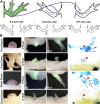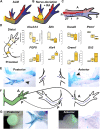Integration failure of regenerated limb tissue is associated with incongruencies in positional information in the Mexican axolotl
- PMID: 37333984
- PMCID: PMC10272535
- DOI: 10.3389/fcell.2023.1152510
Integration failure of regenerated limb tissue is associated with incongruencies in positional information in the Mexican axolotl
Abstract
Introduction: Little is known about how the newly regenerated limb tissues in the Mexican axolotl seamlessly integrate with the remaining stump tissues to form a functional structure, and why this doesn't occur in some regenerative scenarios. In this study, we evaluate the phenomenological and transcriptional characteristics associated with integration failure in ectopic limb structures generated by treating anterior-located ectopic blastemas with Retinoic Acid (RA) and focusing on the "bulbus mass" tissue that forms between the ectopic limb and the host site. We additionally test the hypothesis that the posterior portion of the limb base contains anterior positional identities. Methods: The positional identity of the bulbus mass was evaluated by assaying regenerative competency, the ability to induce new pattern in the Accessory Limb Model (ALM) assay, and by using qRTPCR to quantify the relative expression of patterning genes as the bulbus mass deintegrates from the host site. We additionally use the ALM and qRTPCR to analyze the distribution of anterior and posterior positional identities along the proximal/distal limb axis of uninjured and regenerating limbs. Results: The bulbus mass regenerates limb structures with decreased complexity when amputated and is able to induce complex ectopic limb structure only when grafted into posterior-located ALMs. Expressional analysis shows significant differences in FGF8, BMP2, TBX5, Chrdl1, HoxA9, and HoxA11 expression between the bulbus mass and the host site when deintegration is occuring. Grafts of posterior skin from the distal limb regions into posterior ALMs at the base of the limb induce ectopic limb structures. Proximally-located blastemas express significantly less HoxA13 and Ptch1, and significantly more Alx4 and Grem1 than distally located blastemas. Discussion: These findings show that the bulbus mass has an anterior-limb identity and that the expression of limb patterning genes is mismatched between the bulbus mass and the host limb. Our findings additionally show that anterior positional information is more abundant at the limb base, and that anterior patterning genes are more abundantly expressed in proximally located blastemas compared to blastemas in the more distal regions of the limb. These experiments provide valuable insight into the underlying causes of integration failure and further map the distribution of positional identities in the mature limb.
Keywords: accessory limb model; axolotl; bulbous mass; integration; limb patterning; limb regeneration; retinoic acid.
Copyright © 2023 Vieira, Raymond, Kelley, Cherubino, Sahin and McCusker.
Conflict of interest statement
The authors declare that the research was conducted in the absence of any commercial or financial relationships that could be construed as a potential conflict of interest.
Figures





Similar articles
-
FGF, BMP, and RA signaling are sufficient for the induction of complete limb regeneration from non-regenerating wounds on Ambystoma mexicanum limbs.Dev Biol. 2019 Jul 15;451(2):146-157. doi: 10.1016/j.ydbio.2019.04.008. Epub 2019 Apr 23. Dev Biol. 2019. PMID: 31026439 Free PMC article.
-
Position-specific induction of ectopic limbs in non-regenerating blastemas on axolotl forelimbs.Regeneration (Oxf). 2014 Feb 16;1(1):27-34. doi: 10.1002/reg2.10. eCollection 2014 Feb. Regeneration (Oxf). 2014. PMID: 27499858 Free PMC article.
-
Retinoic acid breakdown is required for proximodistal positional identity during amphibian limb regeneration.bioRxiv [Preprint]. 2024 Aug 9:2024.08.07.607055. doi: 10.1101/2024.08.07.607055. bioRxiv. 2024. Update in: Nat Commun. 2025 Jun 10;16(1):4798. doi: 10.1038/s41467-025-59497-5. PMID: 39149228 Free PMC article. Updated. Preprint.
-
Implication of two different regeneration systems in limb regeneration.Regeneration (Oxf). 2014 Aug 29;1(3):1-9. doi: 10.1002/reg2.16. eCollection 2014 Jun. Regeneration (Oxf). 2014. PMID: 27499860 Free PMC article. Review.
-
Understanding positional cues in salamander limb regeneration: implications for optimizing cell-based regenerative therapies.Dis Model Mech. 2014 Jun;7(6):593-9. doi: 10.1242/dmm.013359. Epub 2014 May 28. Dis Model Mech. 2014. PMID: 24872456 Free PMC article. Review.
Cited by
-
Sall4 regulates downstream patterning genes during limb regeneration.Dev Biol. 2024 Nov;515:151-159. doi: 10.1016/j.ydbio.2024.07.015. Epub 2024 Jul 25. Dev Biol. 2024. PMID: 39067503
-
The salamander limb: a perfect model to understand imperfect integration during skeletal regeneration.Biol Open. 2024 Feb 15;13(2):bio060152. doi: 10.1242/bio.060152. Epub 2024 Feb 6. Biol Open. 2024. PMID: 38319134 Free PMC article. Review.
-
Neural regulation of H3K27me3 during the induction of patterning competency in regenerating Axolotl limb cells.Commun Biol. 2025 Apr 24;8(1):659. doi: 10.1038/s42003-025-08084-x. Commun Biol. 2025. PMID: 40275079 Free PMC article.
-
Protocol for patterning competency assay in regenerative axolotl limb cells using the competency accessory limb model.STAR Protoc. 2025 Jun 27;6(3):103920. doi: 10.1016/j.xpro.2025.103920. Online ahead of print. STAR Protoc. 2025. PMID: 40580475 Free PMC article.
-
Making a new limb out of old cells: exploring endogenous cell reprogramming and its role during limb regeneration.Am J Physiol Cell Physiol. 2024 Feb 1;326(2):C505-C512. doi: 10.1152/ajpcell.00233.2023. Epub 2023 Dec 18. Am J Physiol Cell Physiol. 2024. PMID: 38105753 Free PMC article. Review.
References
-
- Bodemer C. W. (1958). The development of nerve-induced supernumerary limbs in the adult newt, Triturus viridescens. J. Morphol. 102, 555–581. 10.1002/jmor.1051020304 - DOI
Grants and funding
LinkOut - more resources
Full Text Sources

